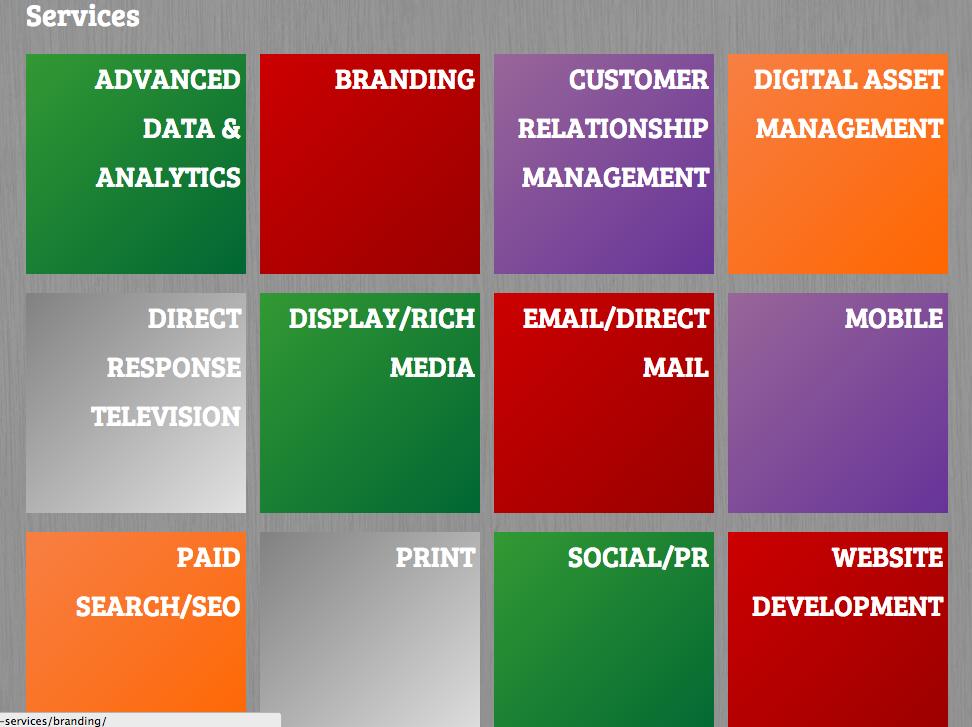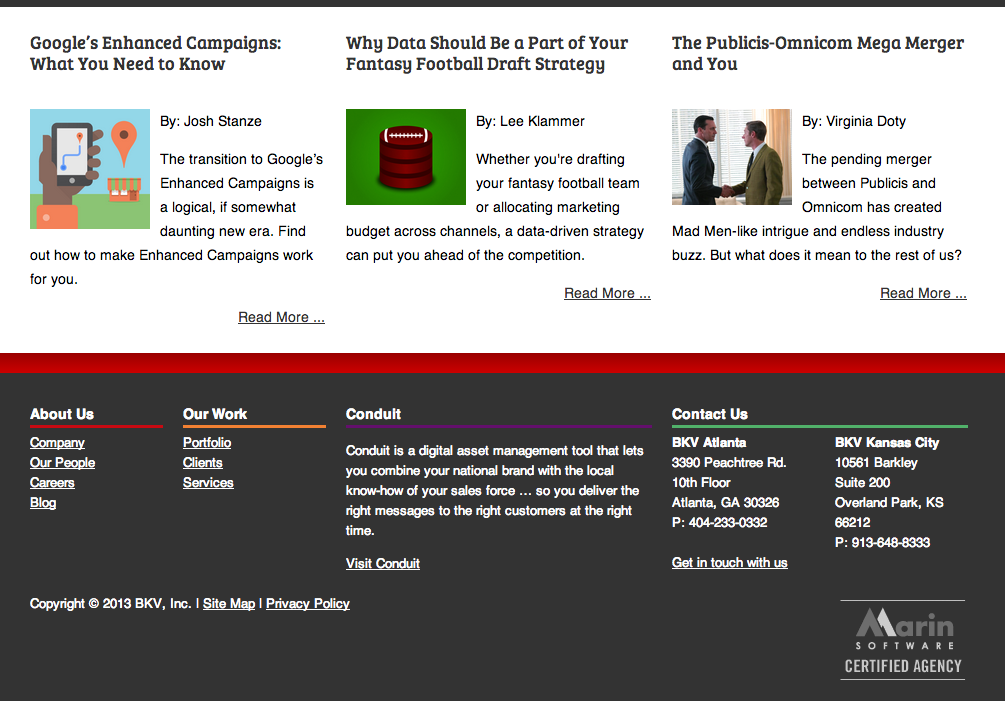Website Rebuild
It all started as a spare time project. We had moved the blogging features of BKV.com into a Wordpress site, but left everything else to exist in a separate CMS. As working in the CMS was proving to be more problematic day to day, I decided to see what it would take to move the remaining site (almost entirely static content) into a static site generator. Its time to start mixing chemicals Dr. Jekyll.
I started by doing an inventory of all the site’s current pages to see exactly what was going to be needed to be rebuilt. I noticed that we had some distinct clusters of data and decided to use Jekyll’s built-in blogging features to handle them. By setting specific categories to groups of posts I am able to loop through just that category for index views.
{% assign services = site.categories['service'] | order_by:'title' %}
{% for service in services %}
<li class="service_entry">
<a href="">
<div class="{% cycle 'green', 'red', 'purple', 'orange', 'gray' %}">
{{ service.title | upcase }}
</div>
</a>
</li>
{% endfor %}

As posts are by default ordered by their creation date, I added a plugin to allow ordering posts by any string value set in their YAML Front Matter. In the case of the services I wanted them alphabetized by title.
Content
To prevent myself from accepting any leftover cruft from multiple developers of varying skill working on previous revisions, I set myself to only grab the content directly from an end-user’s perspective. Instead of pulling it out of the CMS, I visited each page and copied out the raw content. As a result of looking purely at the content, I was able to make some layout decisions without having the restrictions of the templating of the CMS.
By using YAML Front Matter on posts, I was able to seperate the text content from layout specifics. As a result of this change, future layout changes shouldn’t need to modify the content.
---
layout: project
title: Dell SecureWorks
permalink: /direct-marketing/projects/dell-secureworks/
category: project
portfolio_image: dell-secureworks.jpg
images:
- dell-secureworks_01.jpg
- dell-secureworks_02.jpg
---
<section class="project">
<div class="grid">
<div class="unit half images">
<div class="cycle-pager"></div>
<div class="cycle-slideshow"
data-cycle-timeout=4000
data-cycle-pause-on-hover="true"
data-cycle-fx=scrollHorz
data-cycle-pager=".cycle-pager">
{% for image in page.images %}
<img src="{{ image | prepend:'projects/' | asset_path }}">
{% endfor %}
</div>
</div>
<div class="unit half">
<div class="boxed details">
{{ content }}
</div>
{% if page.related_services != empty %}
<div class="unboxed top-spaced">
<h2>Related Services</h2>
<ul class="inline x4">
{% for service in page.related_services %}
<li>
<a href="{{ service.url }}">
<div class="related_service {% cycle 'red', 'purple', 'orange', 'green', 'gray' %}">
{{ service.title }}
</div>
</a>
</li>
{% endfor %}
</ul>
</div>
{% endif %}
</div>
</div>
</section>

Layout
I decided to use Coby Chapple’s Gridism for my grid system after seeing it in action on the new Jekyll site. The simplicity of thinking of the grid in human terms (one-third) instead of number of spans and offsets (span-4 offset-3) of a twelve column grid makes more sense to me and hopefully the next developer.

The Future
Knowing that new case-studies, clients, people, and services would need to be added in the future led me to build a Rakefile with tasks to create new entries. Each task would build out the required YAML Front Matter for a new entry.
desc "Add a new employee"
task :new_person, :name do |t, args|
if args.name
name = args.name
else
name = get_stdin("Enter a person's name: ")
end
filename = "_posts/people/#{Time.now.strftime('%Y-%m-%d')}-people-#{name.to_url}.md"
if File.exist?(filename)
abort("rake aborted!") if ask("#{filename} already exists. Do you want to overwrite?", ['y', 'n']) == 'n'
end
puts "Creating new person: #{filename}"
open(filename, 'w') do |post|
post.puts "---"
post.puts "layout: person"
post.puts "title: #{name}"
post.puts "date: #{Time.now.strftime('%Y-%m-%d %H:%M:%S')}"
post.puts "permalink: /advertising-marketing-agency/people/#{name.to_url}/"
post.puts "category: people"
post.puts "image: #{name.to_url}.jpg"
post.puts "worked_on: []"
post.puts "---"
post.puts "\n# #{name}"
post.puts "\n<dl>"
post.puts " <dt>Title:</dt>\n <dd></dd>"
post.puts " <dt>Industry Experience:</dt>\n <dd></dd>"
post.puts " <dt>Time at BKV:</dt>\n <dd></dd>"
post.puts " <dt>Twitter Handle:</dt>\n <dd></dd>"
post.puts " <dt>Services:</dt>\n <dd></dd>"
post.puts "</dl>"
end
end
➜ rake new_person
Enter a person's name: Testy McTesterton
Creating new person: _posts/people/2013-08-23-people-testy-mctesterton.md